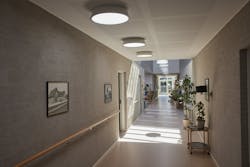Danish nursing home relieved to have circadian lighting again
One way to test the effectiveness of an existing circadian lighting installation might be to replace it with conventional lighting, and then observe whether a building’s occupants notice any difference.
That’s what Denmark’s Bauneparken nursing home tried in the common areas of its dementia wing, experimentally reverting to the conventional system that it used prior to converting to circadian in 2021.
The result? After a 16-week trial with the old lighting, staff reported an increase in discomfort among both employees and residents.
“We have missed circadian lighting a lot,” manager Gitte Ellekilde Andersen said at the end of the 16 weeks. “Several employees, especially evening and night shift workers, have expressed that they have been experiencing headaches and eye discomfort, similar to what they knew from the time before circadian lighting. Some of our residents have become more restless and get up at night, which they otherwise did not do with circadian lighting.”
Bauneparken, about 25 miles northwest of Copenhagen in Skævinge, has since switched again back to the circadian lighting, provided by Aarhus, Denmark–based Chromaviso.
As LEDs Magazine reported a year and a half ago, Bauneparken is also adding personalized circadian lighting to the rooms of individual dementia residents, through an E.U.–backed project called PerCiLight (Personalized and Circadian active dynamic Lighting), which in turn is part of the E.U.’s Active Assisted Living Programme Ageing Well in the Digital World initiative.
PerCiLight is also studying usability of the personalized technology by staff who operate it.
Chromaviso is one of five European lighting and technology firms involved in the Bauneparken project.
Circadian lighting is the practice of tuning light to mimic the spectral content and intensity of the sun over the course of a day with the objective of conforming to human circadian rhythms and thus fostering health and wellbeing.
“We are very happy with our circadian lighting,” Andersen said of the common areas when LEDs first reported on the project. “It supports a natural circadian rhythm, with less activity during the night and more energy during the day.”
She has since welcomed back the restoration of the circadian system.
"It shows the difference circadian lighting makes for our health and wellbeing — I wish that other nursing homes will also have the opportunity to try circadian lighting,” Andersen noted.
MARK HALPER is a contributing editor for LEDs Magazine, and an energy, technology, and business journalist ([email protected]).
Follow our LinkedIn page for our latest news updates, contributed articles, and commentary, and our Facebook page for events announcements and more. You can also find us on the X platform.

Mark Halper | Contributing Editor, LEDs Magazine, and Business/Energy/Technology Journalist
Mark Halper is a freelance business, technology, and science journalist who covers everything from media moguls to subatomic particles. Halper has written from locations around the world for TIME Magazine, Fortune, Forbes, the New York Times, the Financial Times, the Guardian, CBS, Wired, and many others. A US citizen living in Britain, he cut his journalism teeth cutting and pasting copy for an English-language daily newspaper in Mexico City. Halper has a BA in history from Cornell University.




![The DesignLights Consortium continues to make progress in shifting outdoor lighting products and implementation practices toward a more restrained and thoughtful strategy. [Image does not represent a DLC qualified fixture.] The DesignLights Consortium continues to make progress in shifting outdoor lighting products and implementation practices toward a more restrained and thoughtful strategy. [Image does not represent a DLC qualified fixture.]](https://img.ledsmagazine.com/files/base/ebm/leds/image/2024/08/66be810888ae93f656446f61-dreamstime_m_265700653.png?auto=format,compress&fit=&q=45&h=139&height=139&w=250&width=250)
